IT Accessibility in Higher Education (2015)
Proceedings of the February 2015 IT Accessibility in Higher Education Capacity Building Institute (CBI)
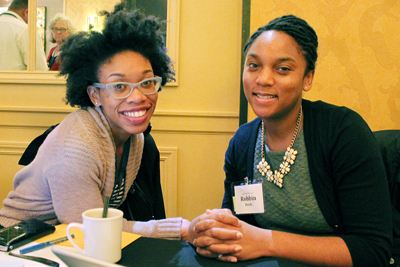
This publication shares the proceedings of IT Accessibility in Higher Education, a capacity building institute (CBI) held in Seattle, Washington on February 4 – 6, 2015. Attendees included disability service professionals, individuals with disabilities, and information technology (IT) professionals from across Washington State. These proceedings may be useful for people who
- participated in the CBI
- want to ensure that people with disabilities have access to postsecondary education
- would like to access resources and explore strategies to help make their campus IT more accessible
- have promising practices to share with others
This event was sponsored by UW Accessible Technology Services at the University of Washington (UW), a UW-IT (University of Washington Information Technology) unit that supports both the Access Technology and DO-IT (Disabilities, Opportunities, Internetworking, and Technology) Centers. These centers are dedicated to empowering people with disabilities through technology and education. They promote awareness and accessibility to maximize the potential of individuals with disabilities and make our communities more vibrant, diverse, and inclusive.
The DO-IT Center strives to
- increase the success of people with disabilities in challenging academic programs and careers
- promote the application of universal design to physical spaces, information technology, instruction, and services
- freely distribute online content, publications, and videos for use in presentations, exhibits, and the classroom
- provide resources for students with disabilities, K-12 educators, postsecondary faculty and administrators, librarians, employers, parents, and mentors
The Access Technology Center (ATC) focuses on ensuring students, faculty, and staff with disabilities have access to technology—including computers, software, and special equipment—that supports them in accomplishing their work. ATC staff help individuals select and use assistive technology and supports a showroom with numerous products, including
- speech and braille output
- screen magnification
- alternatives to the keyboard and mouse
- speech recognition software
- tools to make reading and writing easier and computer use more comfortable
- the capacity to create documents in e-text and braille
The show room includes a collection of accessible science equipment such as automatic stirrers, tactile measuring devices, and talking calculators. The ATC provides braille embossing and tactile graphics for the UW community.
ATC staff promote the development and use of accessible technology products by
- encouraging student computing facilities to include assistive technology
- offering courses, delivering presentations, and conducting ATC tours for UW classes and other groups
- working with campus units to prepare materials in accessible electronic formats
- assisting department web developers in designing accessible websites and applications
- supporting a central resource to provide guidance to technologists and administrators at the UW and beyond
About the CBI
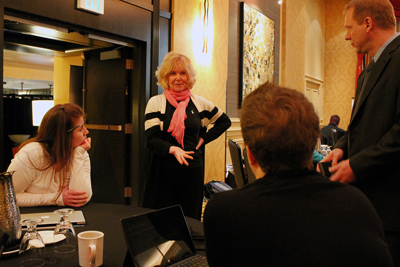
The IT Accessibility in Higher Education CBI provided a forum for sharing interventions and strategies that promote accessibility of IT at colleges and universities. Attendees, in teams of two—a disability service professional and an IT professional from each specific school—came from postsecondary educational institutions across Washington State. Many attendees had disabilities themselves. In total, over fifty participants were in attendance.
The CBI provided a forum to share expertise, practices, suggestions for future collaborations, and funding ideas. Broad issues discussed included
- Ensuring the accessibility of websites; Word, PDF and PowerPoint documents; and learning management systems (LMSs)
- Captioning videos
- Developing accessible online learning courses
- Providing assistive technology
- Promoting universal design and accessible IT
- Exploring legal obligations for creating and using accessible IT
- Considering accessibility in IT purchases
- Engaging IT vendors in accessibility improvements
- Exploring opportunities for future statewide support and collaboration
In small working groups, participants responded to the following questions:
- What barriers do you face on your campus related to IT accessibility?
- What strategies can you implement on your campus to encourage accessibility of webpages, videos, and documents?
- What specific steps, both short term and long term, can you can take to increase accessibility on your campus or to encourage others to do so?
- How can we address the needs identified in the small group discussion? How might we collaborate to support one another?
In this CBI
- all participants contributed to its success;
- experts in all topic areas were in the audience; and
- new concepts evolved from discussions.
The CBI was comprised of presentations, panel discussions, and group discussions. CBI participants shared their diverse perspectives and expertise. The agenda for the CBI and summaries of the presentations are provided on the following pages.
Agenda
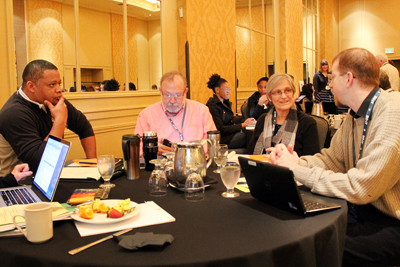
Wednesday, February 4
7 – 9 pm
Reception
Thursday, February 5
8 – 8:30 am
Breakfast and Networking
8:30 – 9 am
Welcome, Introductions, and Goals
Sheryl Burgstahler, University of Washington
9 – 9:45 am
Overview of IT Accessibility Issues
Sheryl Burgstahler, University of Washington
10 – 11 am
Web Accessibility
Terrill Thompson, University of Washington
11 am – 12 pm
Document Accessibility
Dan Comden, University of Washington
12 – 1 pm
Lunch and Discussion
What barriers do you face on your campus related to IT accessibility?
1 – 1:30 pm
Report Out from Lunch Discussion
Sheryl Burgstahler, University of Washington
1:30 – 2:30 pm
Video Accessibility
Doug Hayman, University of Washington
Panelists: Joetta Sieglock, Karen Fusco, Jon McGough, Kathleen Chambers
2:45 – 3:45 pm
Panel: Student Perspectives
Panelists: Cindy Bennett, Kayla Wheeler, Macy Westrick, Alicia Teasley, Tony Ive
3:45 – 4:45 pm
Working with Vendors
Hadi Rangin, University of Washington
5 – 6 pm
Policies, Task Forces, Advisory Boards, Other Administrative Issues
Sheryl Burgstahler, University of Washington
7 – 9 pm
Dinner and Discussion
What strategies can you implement on your campus to encourage accessibility of webpages, videos, and documents?
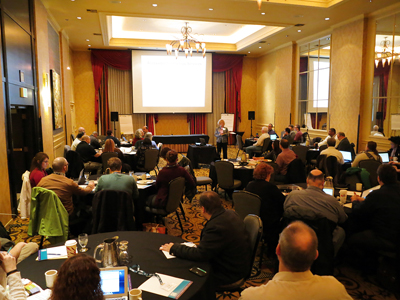
Friday, February 6
8 – 9 am
Breakfast and Networking
9 – 9:30 am
Review of Dinner Discussion
Sheryl Burgstahler, University of Washington
9:30 – 10:30 am
Partner Activity
Participants from each institution will work together to identify specific steps, both short term and long term, they can take to increase accessibility on their campus or to encourage others to do so.
10:30 – 11 am
Report Out
11 am – 12 pm
Discussion
How can we address the needs identified in the small group discussion? How might we collaborate to support one another?
12 – 1 pm
Lunch and Continued Discussion
Evaluation of CBI
Presentation Summaries
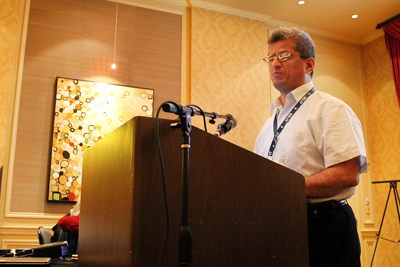
Overview of IT Accessibility Issues
Presenter: Sheryl Burgstahler
In order for IT to be considered accessible to and usable by people with disabilities, it must afford those individuals the opportunity to acquire the same information, interactions, and services as people without disabilities. People with disabilities must be able to obtain and use information presented as fully as people without disabilities. The Department of Justice’s Office of Civil Rights (OCR) and courts of law have resolved civil rights complaints with respect to IT access for individuals with disabilities at more than a dozen postsecondary institutions in the United States. How can these resolutions help guide other campuses in making IT (e.g., websites, videos, online learning) accessible to students, faculty, staff, and visitors with disabilities?
Resolutions to these OCR complaints suggest that institutions of higher education consider
- conducting accessibility audits and developing corrective action strategies
- developing and disseminating an accessible IT policy
- creating IT accessibility standards
- providing training and education
- developing procurement policies and procedures
- developing and publicizing grievance procedures
- addressing accessibility within already developed, procured, and used IT, including websites, LMSs, classroom technologies, and purchased software
The UW has come a long way in spearheading efforts related to making IT accessible since 1984, when IT accessibility support was embraced by the Microcomputer Support Group under what became Computing and Communications (now called UW-IT). In 1990, the Access Technology Lab opened, providing access to assistive technology, and, in 1992, the DO-IT Center received National Science Foundation funding to provide complementary, nationwide efforts. A UW accessible web user group started meeting regularly in 2002, UW hosted a nationwide IT accessibility CBI in 2006, and UW-IT began using Siteimprove to test the accessibility of campus websites in 2011. Since 2012, efforts at UW have increased with the creation of an IT accessibility campus-wide task force, the launch of a proactive initiative to test website accessibility, a draft of wording to include in purchasing questions for IT vendors, and a signed contract with Automatic Sync for captioning.
UW-IT continues to grow and create more promotion, tools, and procedures about accessibility. In the ideal state that we strive for, we would have
- a campus-level task force with annual reports
- a guidance website
- standard accessible web page templates
- IT accessibility consulting/testing services
- accessibility included on IT development and support teams
- collaboration between vendors and UW staff for creating and purchasing accessible software and technology
- IT accessibility courses offered
- accessibility included in general IT training
- accessibility included in IT job postings
- an IT accessibility leader in each campus unit
- captions promoted as a best practice
- grant writers encouraged to include accessible technology in grant outcomes
- accessibility-awareness activities and products
- IT accessibility capacity-building institutes conducted for UW and beyond
- grants secured to supplement and expand the reach of IT accessibility efforts
- leadership related to IT accessibility in professional organizations and publications
- students with disabilities as accessibility testers
Although the UW is not doing all of these things currently, the UW-IT Accessibility Task Force engages in ongoing activities and makes recommendations regarding the enhancement of online resources, the promotion of accessible IT, and iteratively improves policies and procedures. UW is working to promote accessibility within a context of universal design, usability, and an inclusive culture. We are empowering users through Accessible Technology Services, which serves as a resource, catalyst, and community-builder to empower the infrastructure.
Web Accessibility
Presenter: Terrill Thompson
When we’re creating digital content such as web pages or online documents, we may envision our typical user as an able-bodied person using a desktop computer. In reality, users utilize a wide variety of technologies to access the web including assistive technologies, mobile devices, and more; everyone has different levels of ability when it comes to seeing, hearing, or using a mouse or keyboard. Since the World Wide Web was invented, HTML has had alt tags and other accessibility features as one of its standards. WCAG 2.0 (Web Content Accessibility Guidelines, second version) aims to bring all web content up to an accessible level so that all users have equivalent access. WCAG 2.0 follows four main principles; information should be perceivable, operable, understandable, and robust. Each of these principles is defined by more specific guidelines, and those are further defined by specific success criteria, which are assigned Level A, AA, or AAA, with Level A success criteria including the most critical issues for accessibility. Level A success criteria are fairly easy to meet. In resolution agreements and legal settlements, the U.S. Department of Justice and the Department of Education OCR have identified WCAG 2.0 Level AA as a reasonable target to ensure websites are accessible.
A push for accessible tools and features will help make all web content more accessible. Using accessible themes in WordPress and Drupal is an easy way to spread accessibility across campus and utilize necessary accessibility features such as keyboard accessible drop-down menus and proper headings. ARIA (Accessible Rich Internet Applications) can be used to analyze accessibility, and it communicates the interface elements to users and designers. Canvas and similar learning management systems need to be made accessible and used accessibly; faculty need to learn about headings and alt text and the right questions to ask about accessibility.
For more information about web accessibility, check out these resources:
- 30 Tips for Improving Web Accessibility
- Accessible Technology at the UW
- Accessible University Demo Site
Document Accessibility
Presenter: Dan Comden
A document is written, printed, or electronic matter that provides information or evidence. Ignoring video and audio, which are two important but fundamentally different types of files, typical types of documents used on campus are Word, PDF, Plain Text and Rich Text, PowerPoint, and HTML. We need to ensure that all information given to students is accessible.
Evaluating over a hundred courses over a year at the UW, we observed over 5,000 documents used, and over 100,000 pages from those documents were shared through our LMS. Through all of these, the percentage of documents that were accessible was very low. On average, only about 11% of Word documents included headings, one of the most important structural accessibility features in Word. For PDFs, one of the most important features of accessibility is text selectibility so that text-to-speech software can make sense of the document. Most quarters, about 70% or more of the pdfs used were text-selectable. Yet, an average of only 26% of PDFs had bookmarks or tags and less than 8% had both bookmarks and tags.
It is important to focus on headings, lists, alternative text for images, and the language choice for all documents. Headings provide easy navigation of the information for anyone approaching the text. Lists need to be labeled and are a good way to provide structured information to the reader. Alternative text for images allows someone who can’t access the image visually to get a description of the content within an image and allows image content to be searched. Selecting the language provides information to a speech synthesizer. When exporting your document to PDF, make sure you check for accessibility with Acrobat’s accessibility checker. Scanned PDFs can be a huge problem, as they are often just an image rather than text and lack the structure provided by tags. Inaccessible PDFs often need additional software to read, which delays delivery to students.
HTML will always be the most accessible way to convey information, followed by structured Word documents. How do we encourage faculty to use accessible documents? How do we train faculty to create them? These are ongoing questions. The following websites provide tools for making your website accessible:
Working with Vendors
Presenter: Hadi Rangin
UW-IT has been working with vendors for many years to encourage them to increase the accessibility of their products. These vendors include educational vendors such as Blackboard, Desire2Learn, Instructure, Moodle, Ebsco Publishing, Elsevier, Ex Libris, BB Collaborate, Qualtrics, Elucian, and many more. We have received very positive responses from companies, indicating that this sort of collaboration can result in positive changes.
We continue to strive to increase designers’ and developers’ knowledge of accessible design so products that they develop are accessible out of box. The goal is to be able to purchase a product with an accessible design rather than buy a product and address accessibility issues later. Unfortunately, accessibility is rarely included in IT design, implementation, and quality assurance; consequently, many products entering the market are either inaccessible or haven’t been tested for accessibility.
Occasionally, vendors provide Voluntary Product Accessibility Template (VPAT) forms, which is a vendor-generated statement that provides relevant information on how a vendor’s product or service claims to conform to Section 508, IT accessibility standards used by the federal government. Many VPATs emphasize the vendors’ commitments to accessibility without providing a clear description of whether the products are accessible. Purchasers may not be savvy enough to recognize this distinction. Consequently, these products are purchased and deployed on our campuses without being fully tested for accessibility.
Some universities, including the UW, promote the consideration of accessibility as part of the product testing and evaluation in the purchasing process. In these cases, products are tested independently for accessibility and shortcomings are identified. But what should we do when there is no viable alternative for the product being purchased? Should a lack of accessibility be a deal breaker? It all depends on the necessity of the product and the availability of an accessible alternative.
We believe the solution is collaboration. It is important to bring the purchasing department and vendors together to come up with an accessibility plan. A full accessibility/usability evaluation should be performed, issues should be identified and prioritized based on their severity, and a plan should be incorporated into the contract. The contract should specify clearly what issues will be addressed and what the consequences are if the vendor fails to deliver. It is best when the respective campus department leads the collaboration and takes responsibility for following through with the contract. When evaluating a product, it is important to focus on usability rather than technical aspects of the product. Examples of good questions to ask are
- Can users accomplish particular tasks?
- Can users post to a particular forum/thread?
- Can users determine how much time is remaining for their quiz?
Panel Presentation Summaries
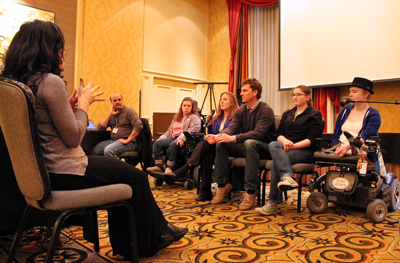
Panel: Video Accessibility
The panel on video accessibility was facilitated by Doug Hayman of UW included four technology and accessibility specialists: Joetta Sieglock, Eastern Washington University; Karen Fusco, Olympic College; Jon McGough, University of Washington; and Kathleen Chambers, North Seattle College. Panel members made the following comments:
- Videos are presented in a myriad of technologies on campus—YouTube, Panopto, Adobe Connect, Tegrity, DVD, and VHS. Because of this diversity, it’s difficult to make a single workflow for captioning and making all video and media accessible.
- Even though captions are critical to ensure videos are accessible to deaf students, advocates in some schools have a hard time getting the support and funding to caption videos.
- Captioning is currently very similar to the situation 25 years ago when buildings didn’t have ramps and physical access was a huge accessibility barrier—now you won’t find a building without a ramp or elevator. Video accessibility is one of the current major challenges on our campuses.
- Can campuses from across Washington State work through one vendor for captioning to secure a reduced cost per minute of captioning?
- If you have an old video without captions, look for a newer version that might have captions.
- Voice recognition software could be used to create a draft version of captions for a video and then student workers could be hired to clean them up.
- There is more to video accessibility than just captioning—audio descriptions for videos are important to ensure accessibility for individuals who have visual impairments. HTML5 supports audio descriptions.
- Content and media needs to be prioritized. Anything that will be visible to the public should be top priority and made accessible first; internal videos can be made accessible on an as-needed basis. Videos used in classes that have a deaf student enrolled should be captioned, but other videos should be captioned as a good teaching practice.
- One of the first steps towards getting accessible media is getting people motivated and excited about captioning and universal design. Most faculty genuinely enjoy helping their students learn, and by helping them see how captions can aide all students, we can get them excited to make their products accessible.
- Able Player is an open-sourced accessible video player that is currently in development. Visit terrillthompson.com/ableplayer for more information.
- What can be built into LMSs to keep accessibility in the forefront? Can they alert the user when a feature is inaccessible?
Panel: Student Perspectives
Five students—Cindy Bennett, Kayla Wheeler, Macy Westrick, Alicia Teasley, and Tony Ive, who have diverse disabilities—shared the types of technology they use and what ensures that they have access.
What technology do you use on a regular basis?
- Surface tablets are lightweight and have a small keyboard, making them easier to use and carry around for some individuals with mobility impairments.
- Speech recognition software like Dragon Naturally Speaking and a standing microphone let me type much faster than I would normally with my limited mobility.
- Sticky Keys, a feature included in Microsoft products, allows me to hit multiple keys at once with only one finger, because it continues to “hold” the key down after it’s pushed. This feature allows me to use normal keyboard shortcuts and other simple keyboard functions.
- E-readers, like the Nook, Kindle, and even the iPad, are great for reading PDFs of textbooks and class readings, so I don’t have to carry a large number of heavy textbooks.
- As a deaf student, I use my Surface tablet for real time captioning, and I also use a note taker in class so I can focus on the captions without feeling like I’m getting behind.
- As a student who is blind, a braille display lets me read text. I also use Jaws, which is a screen reader that provides me with speech output.
- I use Microsoft OneNote to organize all of my notes. It allows me to gather information and organize it in a way that makes sense to me.
- My iPhone has great accessibility features built into it. It has a pretty good screen reader called VoiceOver, and also registers gestures I use over the screen.
- Google Apps for Education used to be very inaccessible, but lately they have made great strides in becoming much more screen reader friendly, so group work can be done more efficiently.
- LiveScribe, a pen that records audio that is linked to written notes, gives me the freedom to not worry that I am missing class material.
What is the biggest difficulty you face while using technology?
- The biggest issue with all visual and text-based documents and web technology—PDFs, websites, LMSs, Google apps, Word documents, and videos—is when they aren’t screen reader friendly. Faculty and others don’t usually realize when they are using inaccessible material in class, and for those of us who using a screen reader is absolutely necessary, this means we cannot use the material.
- Not having captions for videos makes a lot of content inaccessible to me as a student who is deaf. Faculty will sometimes rely on YouTube’s auto-captions without editing them, which don’t work well or solve the problem.
- If you are in an environment where there is a lot of background noise, or a place where you have to be quiet (e.g., the library), then it can be very hard when you depend on Dragon Naturally Speaking or other speech recognition software. In a loud environment, it picks up everything going on and doesn’t distinguish very well between the speaker and the background noise.
- It’s not welcoming when a faculty member declares a class to be a “no tech” classroom. While I understand the concept, it isolates and alienates those of us who have to use technology to manage our disability. I’ve had a teacher call me out on using technology, which meant I had to disclose my disability to the entire class, making me feel very uncomfortable.
What’s your biggest wish?
- For faculty and staff to understand that accessible technology exists and that students use it. For example, if they are providing a PDF file, there needs to be a text-selectable, tagged, accessible version of that PDF.
- For YouTube captioning to be better. I have friends who can just search on YouTube and teach themselves with educational videos; if videos are not captioned, I have to go to the tutoring center or the professor to receive the same opportunity.
- That all schools used the same technology tools. There are a myriad of different systems, software, and learning management systems, each with their own accessibility issues. Just taking the time to learn each different tool and find how to make them work for me is tedious.
- That faculty, instructors, vendors, and staff were educated on accessibility.
- That instructors made sure all homework is accessible before it is given to the students.
Working Group Discussion Summaries
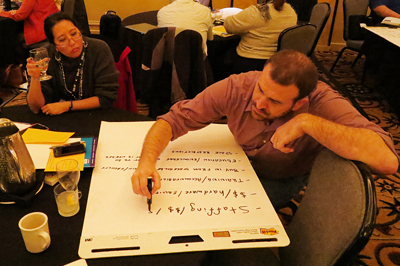
What barriers do you face in your campus related to IT accessibility?
- Money is often a barrier to accessibility, whether it is for purchasing new resources or the amount paid for staff and faculty.
- We need a standardized accessibility checklist that is used across campuses. This could be supplemented with clear procedures for tasks, such as working with vendors to purchase accessible product, how to hold accessibility training, how to caption videos, etc.
- We need more champions within our faculty senate and the federation to address accessibility issues in high-level meetings.
- Outside partners are often resistant to change or don’t make accessibility a priority. This results in, for example, internships and clinicals that are not fully accessible.
- We need a list of quick and easy solutions to start making changes immediately.
- We need to be more proactive, and we need to reframe the issue as being a campus wide problem, not just in the hands of disability services. The culture around accessibility needs to be changed, and faculty, staff, and administration all need to understand the importance of universal design and accessibility.
- A support system should be created so that all colleges and technical institutes can bond together to take on the same issues, and more solutions could be found in a shorter time period.
- No one takes responsibility for accessibility. Someone needs to step up and take it on, possibly creating a centralized hub in IT with one lead manager.
- My campus doesn’t have accessible software or hardware. I need to figure out what we need, obtain funding, and make this technology available.
- There needs to be accountability and ramifications for not being accessible.
- There is a lack of continuous communication, support, and resources. Creating stronger support groups and making sure everyone knows whom to contact with questions would be helpful.
- Too often, departments make their own purchases without considering accessibility. We need to make all departments aware of the legal issues and have a stake in making an accessible campus.
- There’s a lack of top down pressure; if we get those at the top involved in accessibility change, then they will help ensure that their employees follow suit.
- There needs to be a huge push towards getting everyone on campus concerned about accessibility. It isn’t a priority on anyone’s agenda, people don’t understand the impact accessibility can have, and an ongoing historical institutional inertia for all changes, especially for tenured faculty and long-term staff.
- In such a broad topic, it can be hard to figure out where to start. A few IT members should be trained on accessibility issues and help others across campus tackle low hanging fruit.
What strategies can you implement on your campus to encourage accessibility of webpages, videos, and documents?
- Create a video starring campus leaders to invite more administration and faculty buy-in for campus-wide accessibility. This will help raise awareness and build acceptance.
- Develop an accessible campus guide to instruct professors and staff as well as start a bigger picture conversation.
- Collaborate with other schools on a district-wide accessibility push. This can include weekly accessibility tips, strategic IT project planning, and a push for searchable captions to improve everyone’s experiences.
- Share resources with other schools.
- Hold training sessions with stakeholders, including the IT department, disabilities services, marketing communications, and faculty. Teach faculty about web and document accessibility and about the sort of assistive technology their students might use.
- Create an interdepartmental accessibility taskforce at each college that looks at goals that can realistically be achieved. Track activities and create an annual report.
- Make sure there is a strong, ongoing relationship between disability services and IT staff. Forming a partnership will put accessibility at the forefront of all IT’s projects and teach members of IT about disability, accommodations, and universal design. Provide training and plan goals together.
- Hold paid strategizing sessions with students with disabilities to encourage participation and to learn the problems and solutions from the students themselves.
- Focus on short-term goals and long-term goals separately. Choose what you can fix now by looking at the OCR cases for ideas on what can be changed easily and then plan for the future. Creating a gap analysis is a great way to set the ideal situation and see where you need to close the gap.
- Send stakeholders to conferences on accessibility, including Accessing Higher Ground and the California State University Northridge Annual International Technology and Persons with Disabilities Conference.
What are some short- and long-term steps you can take to increase accessibility on campus?
- Install Kurzweil, Dragon, and NVDA, as well as other accessible software, in multiple computer labs across campus.
- Train staff and faculty on accommodations, accessible documents and websites, and the different accessibility software. Hold a retreat for faculty based solely on accessibility and how to make their courses more accessible. Include instructors who teach online, since it is especially important for their classes to be accessible.
- Create a high-level task force, including high-level stakeholders, as well as people across departments. Include faculty, and staff from purchasing, library, IT, web, disability services, as well as students. Publish IT accessibility reports in order to track improvements and efforts.
- Provide documentation and other resources for staff and faculty to learn about accessibility, universal design, and how to implement both into their courses.
- Establish a baseline for what is to be expected for accessibility in classes, on campus, and on the web.
- Run an accessibility checker and use accessibility tools on all college websites and fix current accessibility issues. Invite an accessible technology technician to create more accessible websites and to provide ongoing support to faculty in building better websites.
- Caption all videos associated with classes and on campus, and make sure only captioned videos are used in class. Caption lectures when they are provided in a video format online.
- Use social media and collaborate with different groups using Facebook and Twitter, including DO-IT.
- Create an annual report on campus accessibility to build awareness, measure the progress of goals, and showcase what has been done and still needs to be done.
- Develop captions, audio description, and transcripts for all e-learning videos.
- Plan an accessibility audit, and especially make sure your LMS is accessible. Use screen readers to test all websites.
- Look at tools specifically designed for doing science, technology, engineering, and math online, like math markup languages and tools for doing math and science homework.
- Find quick accessibility fixes and tackle those first, before looking at long-term goals for accessibility.
- Look at different ways to find funding for accessibility features and goals, especially for captioning videos.
- Raise awareness about universal design on campus and promote it as a tool for everyone, not just students with disabilities. Create videos and campus promotions around these goals, and promote a culture of accessibility and diversity awareness. Host an event for the 25th anniversary of the Americans with Disabilities Act (ADA).
- Create accessible policies and procedures to make it mandatory for all staff and faculty to follow accessibility guidelines.
- Work with a captioning vendor and partner with other schools to meet cost goals and provide all the captioning and accessible video services necessary.
- Create more accessibility resources, and make sure they get into the hands of staff, faculty, and students.
- Make sure campus maps include accessibility features.
- Make sure class schedules and registration are accessible to everyone, including those using screen readers.
- Create an accessibility checklist to determine what needs to be done across campus and where priority lies.
- Partner with other stakeholders from a variety of departments on campus—IT, web, e-learning, library, purchasing, instructors, and others—to create community around accessibility issues.
- Engage your ADA compliance officer in conversations about IT accessibility.
- Encourage the faculty senate or council to ask whether faculty have considered IT accessibility, or accessibility more broadly, when they propose a new course.
- Involve students to create a grassroots effort to promote accessibility.
How can we address the needs identified in the small group discussion? How might we collaborate to support one another?
- Pool together our funding between schools across Washington State to contract with one captioning vendor at a discounted rate.
- Engage with all of the eLearning directors from the 34 community colleges through the eLearning Council to determine how to ensure online learning is accessible.
- Create a community of practice (CoP) for accessible IT in postsecondary education in Washington and have a listserve specifically for it. Share resources from conferences and information learned via this CoP. (See below for more information about the Accessible IT CoP.)
- Meet before the Washington Association on Postsecondary Education and Disability (WAPED) meeting every year to check in on efforts and continue to invite others to meet as well. This year, the WAPED meeting will include a talk by the IT director of University of Montana, who will discuss their resolution to the Office of Civil Rights complaint two years ago. Learn more about WAPED.
- Get on the Northwest Managers of Educational Technology (NWMET) conference agenda for the meeting to be held in April in Walla Walla. Learn more about NWMET.
- Have an IT accessibility constituent group present at EDUCAUSE regional and national events.
- Connect across social media—Facebook, Twitter, and so on—to create a connected online presence.
- Hold a one-day meeting before or after Accessing Higher Ground.
- Negotiate with vendors and work together to get accessible products and services, especially for eLearning.
- Join the Access Technologist Higher Education Network (ATHEN).
- Partner with each other to draft statements or commitments about IT accessibility.
CBI Participants
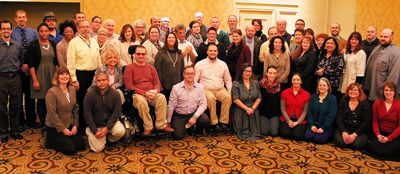
Stakeholder groups represented in the CBI included
- student service leaders and administrators,
- faculty members,
- students, and
- professional organizations
The following individuals participated in the CBI.
Lora Allen
Disability Services Coordinator
Big Bend Community College
Cindy Bennett
Student
University of Washington
Brianna Blaser
Program Coordinator
DO-IT, University of Washington
Sheryl Burgstahler
Director
DO-IT, University of Washington
Bree Callahan
Director, Disability Resources for Students
University of Washington
Jean Carlson
Program Coordinator
Green River Community College
Anne Carpenter
Assistive Technology Specialist
Bellevue College
Kathleen Chambers
Instructional Designer
North Seattle College
Cebrina Chavez
Program Coordinator DSS office
Seattle Central College
Dan Comden
Assistive Technology Manager
University of Washington
Lyla Crawford
Program Coordinator
DO-IT, University of Washington
Max Denton
Information Technology Specialist
Olympic College
Nancy Dvojack
Program Assistant
Spokane Falls Community College
Angela Earley
Assistant Director in ITS
Washington State University
Rick Ells
Senior Webmaster, IT
University of Washington
Karen Fusco
Director of Access Services
Olympic College
Mary Gerard
Coordinator of Accessibility Resources
Bellingham Technical College
Tom Gibbons
Instructional Designer
South Seattle / Seattle Central Colleges
Krista Greear
Access Text Manager
University of Washington
Natalie Grosser
Student Services Counselor
Washington State University
Marie Hammer
IT Specialist
Seattle Central College
Brian Hansen
System Administrator
Green River College
Doug Hayman
Senior Computer Specialist
DO-IT, University of Washington
Michael Hoel
Director of Disability/Veteran Services
Centralia College
Tony Ive
Student
University of Washington, Continuing Education
James Johnson
Interim eLearning Director
Pierce College Puyallup
Rose Kolovrat
Director of Disability Services
South Seattle College
Patrick McEachern
Instructional Designer
Spokane Falls Community College
Jon McGough
Assistant Director
University of Washington
Rick McKinnon
Director of eLearning
South Puget Sound Community College
Susan McPhee
Access and Disability Services Manager
Pierce College Fort Steilacoom
Michael Mesa
Access and Disability Services Manager
Pierce College Puyallup
Michael Owens
Associate Chief Technology Officer
Eastern Washington University
Curtis Perera
IT Director
Bellingham Technical College
Sherman Peterson
Access Services & Technology Specialist
Tacoma Community College
Jon Pielaet
Assistive Technology and IT Accessibility Specialist
Clark College
Vicki Place
IT Technician
Columbia Basin College
Carrie Powell
eLearning Support Manager
Centralia College
Lori Pritchert-Johnson
Program Coordinator of Adaptive Technology and Alternative Formats
Spokane Community College
John Rajcich
Assistant Director of Diversity and Equity
South Puget Sound Community College
Hadi Rangin
IT Accessibility Specialist
Accessibility Technology Services, University of Washington
Kamran Rasul
Director of Assistive Technology
Columbia Basin College
Lucas Reber
Director of Information Technology and Media Services
North Seattle College
Robbin Riedy
Assistant Director of Educational Technology and Media
Seattle Pacific University
Benjamin Sharp
Desktop Support Manager
Spokane Community College
Chip Shelton
District IT Manager
Pierce College Fort Steilacoom
Joetta Sieglock
Adaptive Technology Specialist
Eastern Washington University
Christopher Soran
Interim eLearning Director
Tacoma Community College
Hope Stout
Disability and Veterans Resources Coordinator
Clover Park Tech College
Michael Taylor
Director, IT
Clover Park Technical College
Alicia Teasley
Student
University of Washington
Terrill Thompson
Technology Accessibility Specialist
University of Washington
Angela Tucker
Disability Support Services Coordinator
Seattle Pacific University
Zach Welhouse
eLearning Coordinator
Big Bend Community College
Macy Westrick
Student
University of Washington
Kayla Wheeler
Student
University of Washington
Jason Wiscarson
IT Applications Developer
Clark College
Communities of Practice
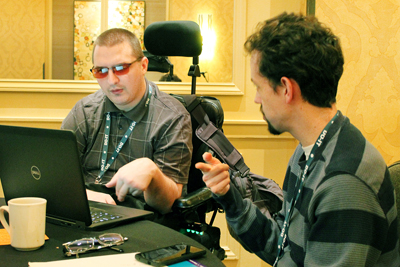
With supplement funding, DO-IT engages stakeholders within Communities of Practice (CoPs). CoPs share perspectives and expertise and identify practices that promote the participation of people with disabilities in postsecondary education. The Accessible IT CoP was developed as a result of this CBI.
Accessible IT CoP
This CoP is populated with disability services and IT professionals interested in increasing the accessibility of IT in postsecondary education. Participants
- exchange information, ideas, and suggestions for future collaboration
- gain and share knowledge and help identify issues related to IT accessibility in higher education
- recruit others to participate in the CoP
- provide content for DO-IT’s searchable Knowledge Base
You and your colleagues can join the CoP by sending the following information to doit@uw.edu:
- name
- position/title
- institution
- postal address
- email address
- name of the CoP
For information about other CoPs hosted by DO-IT, consult Communities of Practice.
Resources
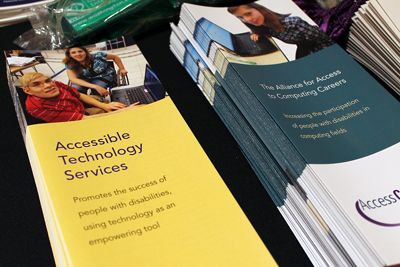
The DO-IT website contains
- information about DO-IT projects
- evidence-based practices that support project goals and objectives
- resources for students with disabilities
- educational materials for teachers and administration
DO-IT maintains a searchable database of frequently asked questions, case studies, and promising practices related to how educators and employers can fully include students with disabilities. The Knowledge Base is an excellent resource for ideas that can be implemented in programs in order to better serve students with disabilities. In particular, the promising practices articles serve to spread the word about practices that show evidence of improving the participation of people with disabilities in postsecondary education.
Examples of Knowledge Base questions include the following:
- Are electronic whiteboards accessible to people with disabilities?
- Are peer review tools accessible?
- Are there computer keyboards designed to be used with only one hand?
- Are touch screens accessible?
- Do postsecondary institutions have to provide assistive technology (for example, screen enlargement or voice recognition software) to students with disabilities who enroll in distance learning courses?
- Does a postsecondary institution have to provide specific hardware or software (known as assistive technology) that an individual with a disability requests so that they can access information technology used on campus?
- Does making our school web content accessible mean I cannot use multimedia on my site?
- How can educational entities determine if their websites are accessible?
Individuals and organizations are encouraged to propose questions and answers, case studies, and promising practices for the Knowledge Base. Contributions and suggestions can be sent to doit@uw.edu.
For more information on making your campus technology accessible and to learn more about accessible learning or universal design, review the following websites and brochures.
- The University of Washington’s hub for information on accessible technology, featuring how to create and develop accessible documents, videos, and websites, can be found at Accessible Technology.
- The Access Technology Center’s website.
- A list of thirty different web accessibility tips, and how to implement those tips, can be found at 30 Web Accessibility Tips.
- Accessible University’s website featuring common web accessibility principles and solutions.
- A brochure on universally designing distance learning programs can be found at Equal Access: Universal Design of Distance Learning Programs.
- A brochure on what accessible distance learning is and how it helps students can be found at Accessible Distance Learning.
- A brochure on why accessible web design matters, and some resources to make your website accessible, can be found at Accessible Web Design.
- More information on universal design in education can be found at the Center for Universal Design in Education.
Acknowledgments
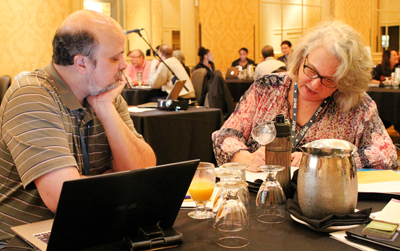
The Washington Accessible IT capacity building activities are funded by Access Technology Services at the University of Washington. Any opinions, findings, and conclusions or recommendations expressed in this material are those of the CBI presenters, attendees, and publication authors and do not necessarily reflect the views of the University of Washington.
DO-IT
University of Washington
Box 354842
Seattle, WA 98195-4842
doit@uw.edu
www.washington.edu/doit/
206-685-DOIT (3648) (voice/TTY)
888-972-DOIT (3648) (toll free voice/TTY)
206-221-4171 (FAX)
509-328-9331 (voice/TTY) Spokane
Founder and Director: Sheryl Burgstahler, Ph.D.
Program Manager: Scott Bellman
© 2015 University of Washington. Permission is granted to copy this publication for educational, noncommercial purposes, provided the source is acknowledged.